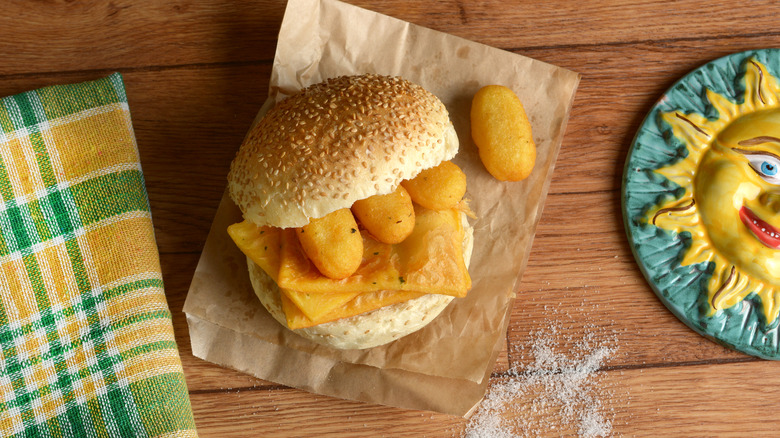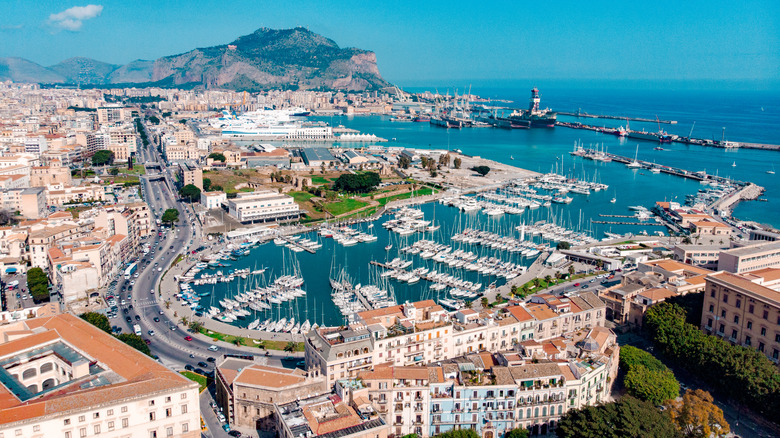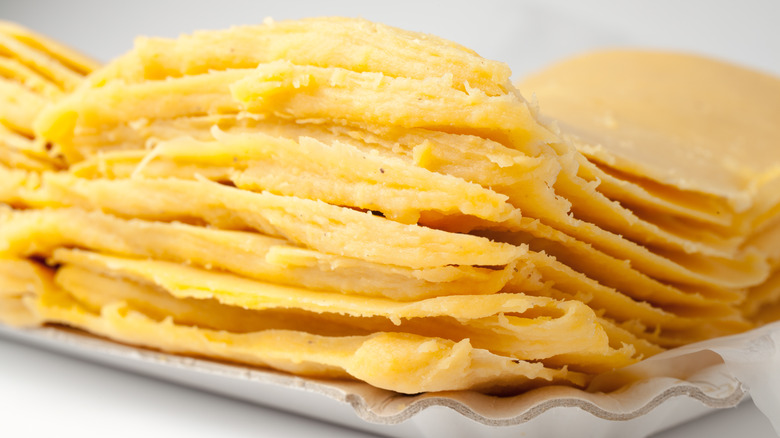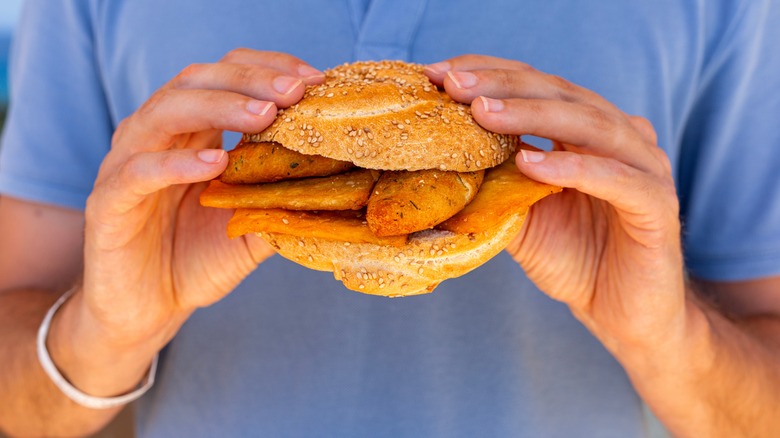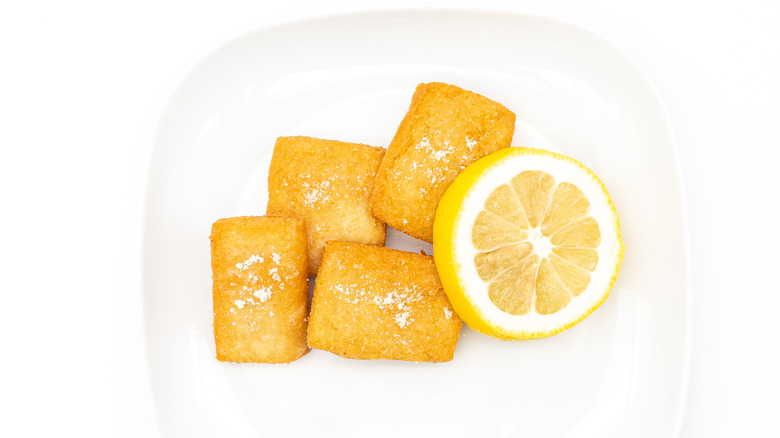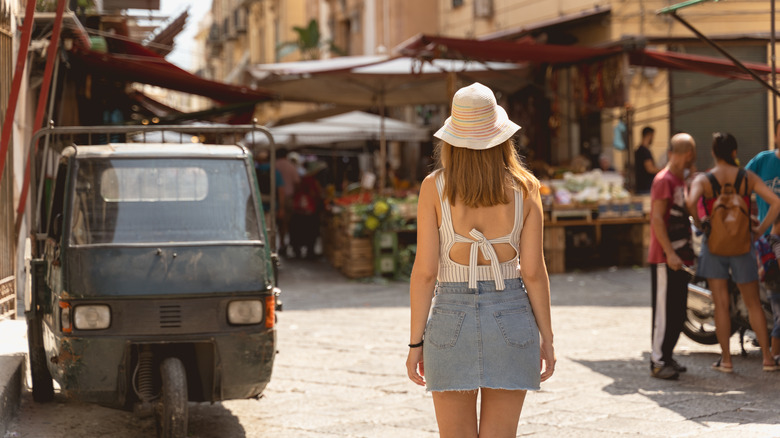Panelle Is The Sicilian Street Food Made From Chickpeas You Need To Try
Although the country's top restaurant features a meat-free tasting menu, Italian cuisine isn't one that's typically associated with plant-based eating — but the more you explore, the more you find. With panelle, however, you won't have to look as far as the streets of Palermo, Sicily, where the chickpea fritters are served hot, fried, and crisp on what's known as a panino, or an Italian sandwich made on a small loaf of bread. Drizzled with a hit of fresh lemon and sprinkled with fresh, green herbs, panelle is about as simple as it gets, showcasing that Italian cuisine is about much more than meat and cheese.
At its core, Italian cuisine, and Mediterranean-Italian cuisine especially, is one that embraces seasonal, low-cost, local ingredients in dishes that sometimes, as in the case of panelle, turn out also to be plant-based. Whether they're served at dinner as an appetizer or from a food truck as a sandwich — or as they're known in Italian, a "pane e panelle" — these humble fritters are proof that plant-based ingredients like chickpeas are meaningful to the local Sicilian lifestyle, serving as the base of what's widely considered to be one of the island's most famous street foods.
History of panelle
While panelle might be considered one of the most iconic Sicilian food delicacies today, that was not always the case. The fritters weren't actually introduced until between the 9th and 11th centuries — during a time when North African forces were conquering the island of Sicily. The Moors, a term used to distinguish North African Muslims, were the first to take the chickpeas that grow abundantly across the basin of the Meditteranean, dry and grind them into flour, mix them with water and spices, cook them, and then later fry them in hot oil. Miraculously, the panelle recipe hasn't changed since. However, attitudes towards it have.
Due to the inexpensive nature of the ingredients used, panelle was initially considered a part of the "cucina povera," or poor man's kitchen. Uncoincidentally, the same was once said about other legume-based foods like Peruvian chocho. But, as is the story with most fried foods, even the most distinguished of people couldn't resist the lure of these fritters — especially after they had been dressed with fresh lemon juice and parsley. Sold as an alternative to fish at fry shops, some of Sicily's most notable public figures began to partake in panelle, from famous writers like Leonardo Sciascia to painters like Renato Guttuso. In time, even the most rich and noble Sicilians were eating it — making it one of the first foods to cross social classes.
How panelle is made
As the saying goes, don't fix what isn't broken. Clearly, that's something that the North African and Sicilian culinary attitudes embrace, seeing as the recipe and method for making panelle originated sometime between the 9th and 11th centuries and hasn't changed since. As noted above, it was the Moors who first made panelle, and it's made the same to this very day. Just as was done during the North African invasion of Sicily, panelle is made by mixing chickpea flour with water and spices. The mixture is then boiled, creating a texture similar to polenta. Then, it's spread out into a thin layer on a baking sheet and allowed to cool before being cut into shapes and fried in oil until golden and crispy.
What makes panelle so accessible and so affordable is the minimal number of ingredients it uses. For this reason, spices are kept to a minimum and usually only include the addition of salt, pepper, and fresh parsley. Both the salt pepper and parsley are mixed into the chickpea batter before it's fried; however, additional parsley is also added after the fact. When used for sandwiches, or as they're known in Italian, "pane el panelle," the panelle is cut into large squares and paired with traditional Sicilian sesame bread. However, they can also sometimes be cut into different shapes — such as diamonds or rectangles — when they're offered as an appetizer. Either way, they always get a squeeze of fresh lemon prior to eating.
What does panelle taste like?
Because the main ingredient in panelle is chickpea flower, these fritters end up tasting a lot like them — but in the best way possible. In fact, the story goes that when the Moors came to Sicily centuries ago and first started making the fritters, they took a taste of the chickpea mixture after it was cooked and decided that they didn't really like how the panelle tasted. So, what'd they do? They fried them until they were hot and crispy — and thankfully so. Panelle is delicious and mildly nutty, but it's the crispiness that really takes them up a notch. Then, when they're hit with fresh lemon juice, they're elevated even more.
As mentioned before, panelle is traditionally enjoyed one of two ways: either on its own as an appetizer or between two slices of bread as a sandwich. On their own, the fritters work as a delectable snack while you're sitting down for wine or cocktails before a meal — but be careful, they can be hard to stop eating. Some even compare them to potato chips, which we all know are addicting. The fritters can also be thrown on top of a salad as a protein with balsamic and cheese if you want to sneak in some greens. As a sandwich, however, the panelle is a tad more filling. Picked up from a local cafe, street cart, or food truck, they're the perfect quick and tasty lunch to grab while you're on the go.
Nutritional information
Being a fried food, panelle is surprisingly nutritious. Most of that has to do with the fact that they're made from chickpea flour. Not only does it make them gluten-free, but it also makes them chop-full of plant-based protein — which all of you vegetarians and vegans reading this should be excited about. In fact, on average, each piece of panelle you eat will provide one to five grams of protein depending on how thick they are. But, like potato chips, you're never going to have just one of these crispy fritters. You'll easily eat the entire tray, which would be okay, seeing as they also contain the added benefits of calcium, iron, and potassium with a quarter of the carbs, fat, and sodium found in your average bag of Lays.
That being said, fried foods aren't generally associated with health. Regular consumption of foods that have been dropped in hot oil until they're beautifully golden brown is no doubt enjoyable, but, as with all good things, too much can have its drawbacks. Due to the high concentration of saturated and trans fats, a 2021 meta-analysis found that people who consume fried foods on a regular basis have a higher risk of developing heart problems, including coronary artery disease, major cardiac events, heart failure, and stroke. Fortunately, panelle contains less than other fried foods such as french fries or fish. But, if you're really watching your intake, some say that they're just as good baked.
Where to get panelle
Panelle is a common street food in Sicily, but especially in Palermo. There, it can be found served from bars — which, in Italy, are more like cafes — food trucks, and even stands attached to the back of motorbikes. While you can visit restaurants to get your fix of these fritters, keep in mind that panelle is, and always has been a humble food. Sold for as little as $3, panelle is not meant to be fancy, and it's best when it's enjoyed that way. Eat like a local Italian and stop at a stand on the street for a quick, casual bite while you're exploring the city, or enjoy it as an appetizer with a nice, cold, Italian beer.
It probably comes as no surprise to learn that the best panelle is found in Palermo. Some of the most rated vendors include the likes of Dainotti's Cibo di Strada in the El Capo market and Nni Franco U Vastiddaru near the El Capo port. But, if you want to get a good one without going all the way to Italy, your best bet will be to find a Sicilian restaurant near you. Amuni, a Sicilian restaurant in Brooklyn, New York, has a panelle sandwich that's garnered some buzz. So has Sfera, a Sicilian street food cafe in Chicago. But, depending on where you live, you may have to do your own research — or, you could always try your hand at making it yourself.
